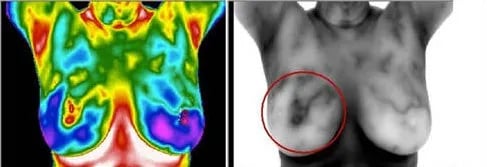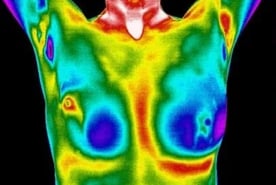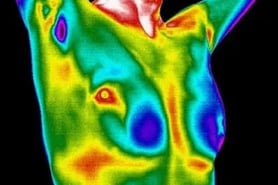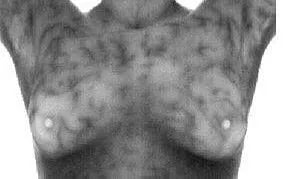
Breast Screening
Breast Imaging
The breast thermal imaging series includes 7 images of the complete chest, breasts; Axillary regions, anterior, oblique, lateral and inferior views.
Breast thermography can aid in the assessment of various dysfunctions, diseases, and other concerns in the breasts to include:
Breast Cancer
Dense Breast Tissue
Fibrocystic Breast Condition
Inflammatory Breast Cancer
Breast Cancer
According to the American Cancer Society, 1 in 8 women in the US will experience a breast cancer diagnosis in their lifetime. There are over 20,000 cases of breast cancer each year in women between the ages of 20-40. When cancer occurs in younger woman it is usually a much more aggressive form, and less likely to respond to treatment. Currently, there is no routine screening method recommended for women under the age of forty. Breast thermography can help fill that void. When used as part of an early detection program it gives a baseline for breast health, and provides a clinical marker for women of any age.


This woman was diagnosed with a 2.4 cm tumor behind the right nipple (retroareolar carcinoma) following her thermography screening. She had several mammograms prior that did not detect this tumor. According to cancer.gov mammography misses up to 20% of tumors overall, and statistically is ineffective in younger women, especially those with dense breast tissue.
Dense Breast Tissue
Dense breast tissue refers to the appearance of breast tissue on a mammogram. Breast tissue is composed of milk glands, milk ducts and supportive tissue (dense breast tissue), and fatty tissue (nondense breast tissue). When viewed on a mammogram, women with dense breasts have more dense tissue than fatty tissue. Dense breast tissue appears as a solid white area on a mammogram, which makes it difficult to see through. Having dense breast affects women in two ways
Increased probability breast cancer may go undetected by a mammogram, as dense breast tissue can mask a potential cancer
Increases your risk of breast cancer with the cause yet associated by doctors
As do many, this woman has dense breast tissue. Her experience meant repeated mammograms, ultrasounds, MRIs, and biopsies, all ultimately finding nothing, but subjecting her body to additional radiation, surgical procedures and discomfort. Following the most recent mammogram she received the familiar letter that findings were inconclusive and that a repeat mammogram and ultrasound were needed. After years of hearing these same words, she was tempted to skip the follow up which showed nothing. She then opted for an alternative screening tool she had heard; thermography. She had her first thermography screening just two weeks following her annual mammogram. The thermogram showed an area of suspicion and prompted her physician to further investigate, which ultimately lead to a cancer diagnosis.




This woman was diagnosed with stage 2 invasive ducal carcinoma following a thermography screening and biopsy. The density of breast tissue does not effect the accuracy or effectiveness of breast thermography.
Fibrocystic Breasts
It is estimated that over half of all women will experience fibrocystic breasts at some time in their lives, making it a very common condition. It is a benign (noncancerous) condition characterized by round lumps filled with fluid that move freely within the breast tissue and generally expand and shrink with the onset and end of the menstrual cycle. This breast condition is most commonly found in women in their 20s to 50s, and is most pronounced in women during their 40s. Common symptoms include tenderness and discomfort, as well as more noticeable lumps which are usually present the week before menstruation begins. A fibrocystic condition is an example of a physiological change within the body in relationship to a hormonal imbalance that thermography can detect.




These images are two examples of fibrocystic breast conditions. When there is an excess of estrogen in the body, referred to as estrogen dominance, it flows into different tissues of the body, including the breasts creating a fibrocystic breast condition. This is seen and describe as mottling patterns on a thermography report.
Inflammatory Breast Cancer
Inflammatory breast cancer (IBC) is a very aggressive disease in which cancer cells block lymph vessels in the skin of the breast. Although IBC is rare, accounting for 1-5% of all breast cancers diagnosed in the US, it progresses rapidly, often in a matter of weeks or months. Its aggressive nature makes early detection critical. IBC is different than other forms of breast cancer, and it is difficult to diagnose. There is usually no lump that can be felt during physical examination, or detected with mammography or by ultrasound, and is often mistaken for infection.








Signs of Inflammatory Breast Cancer Include:
Enlargement in one breast
Bruised or pinkish-red appearance
Heat radiating from the breast
Dimpling on the surface of the skin
Inverted nipple
Pain or tenderness
Enlarged lymph nodes around the area of the breast, under the arm or above the collar bone
Address
3285 South Country Trail, Suite 4 East Greenwich, RI 02818
Hours
Monday - Friday: 8:00 am - 5:00 pm
(401) 214-7317
Contact Information
Saturday: 8:00 am - Noon


